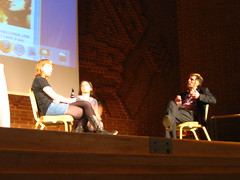A couple of Slovenian newspaper sites redesigned recently (today?). I got the news on Twitter. I’ll try to review what they’ve done.
Delo
 Image via WikipediaFirst notified by had, I was eager to see the new design and code. The design is very very wide — a good link to the newspaper that is probably the widest/biggest in Slovenia. At 1024×768 you see all the content, but the banner on the side is missing — I hope they subtract these users when selling ad space (or they should get ToboAds that actually count only the ones that are seen by the user using advanced JavaScript).
Image via WikipediaFirst notified by had, I was eager to see the new design and code. The design is very very wide — a good link to the newspaper that is probably the widest/biggest in Slovenia. At 1024×768 you see all the content, but the banner on the side is missing — I hope they subtract these users when selling ad space (or they should get ToboAds that actually count only the ones that are seen by the user using advanced JavaScript).
The design is boring with only the RSS icons giving it some color. It gives no feedback on links, the font on the front page is too small (11px) and it doesn’t hold its text–resizing well. The content is a bit hard to read with the font size at 12px, width of 600px (50em) and line–height at normal. There doesn’t seem to be any vertical rhythm applied. It’s also very hard to figure out where you are in the structure since some of the navigational elements seem to vary in color for no apparent reason.
The underlying code is disappointing. It’s really something that you would just delete and start over. It suffers from inline styles, divitis, classitis, inline scripts, validation errors (163 for the front page) and overall ugliness. The front page needs 67 requests and 724kB to load in 3.24 seconds (there are a few banners on the site though). Disappointing but expected is the fact that they don’t use Microformats but I was positively surprised that you can use OpenID to log in — I’ve never left a comment on local news sites because you need to register with each one. And I never do.
Mladina
Posted by Tomaž Štolfa it’s actually not available yetavailable now through www.mladina.si but can be accessed directly through www.mladina.si/dnevnik/. It’s a nice page but with a shift in concept — the magazine is a weekly publication while the online edition will publish daily (or probably all the time). It too is wider than the previous version with a width of 1024 leaning on the left side of the browser.
The design is nice and gives good feedback in use. It’s made on a simple 5—column grid with the 5th column being used only in the head and for the banner. The only thing that is quite annoying is the banner at the top that moves the whole page down another 90px for no good reason (at least not for the users?). The content is much easier to read with a 12px font size, 1.5em line–height at 563px width (~47em). It also makes use of few different typeface which adds to the overall experience of surfing. Vertical rhythm in text is achieved through crappy code with paragraphs being spaced with <br /> elements.
The code is nothing to look at. It has 71 validation error on the front page with the first ones starting in the head element (unclosed meta elements). It too sports inline styles and scripts (which are at least wrapped in CDATA) and it too suffers from a heavy infection of divitis. It even has some <center> tags that I haven’t seen for quite some time now. The front page loads in 2.54 seconds for 58 requests and 582kB with all requests except Google Analytics going to the same domain. Microformats are nonexistent and so is OpenID — no need to have registration if you can’t leave comments.
 Image via WikipediaThis post was written via the newly published Zemanta Reblog, the first feature I worked on at my new job. I helped evolve and implement the interface, which is not perfect yet but is better and will get even better in the future. Reblog feature also gives you an idea of how Zemanta Suggest works since you can see the sidebar on the right hand side of the content as you’re writing it. Reblog is only one of many features we released today – we now support more platforms, more browsers and we also have a few plug-ins for blogging platforms. Read about the release or check the interview with our co-founder and CTO Andraž Tori at ReadWriteWeb.
Image via WikipediaThis post was written via the newly published Zemanta Reblog, the first feature I worked on at my new job. I helped evolve and implement the interface, which is not perfect yet but is better and will get even better in the future. Reblog feature also gives you an idea of how Zemanta Suggest works since you can see the sidebar on the right hand side of the content as you’re writing it. Reblog is only one of many features we released today – we now support more platforms, more browsers and we also have a few plug-ins for blogging platforms. Read about the release or check the interview with our co-founder and CTO Andraž Tori at ReadWriteWeb.







